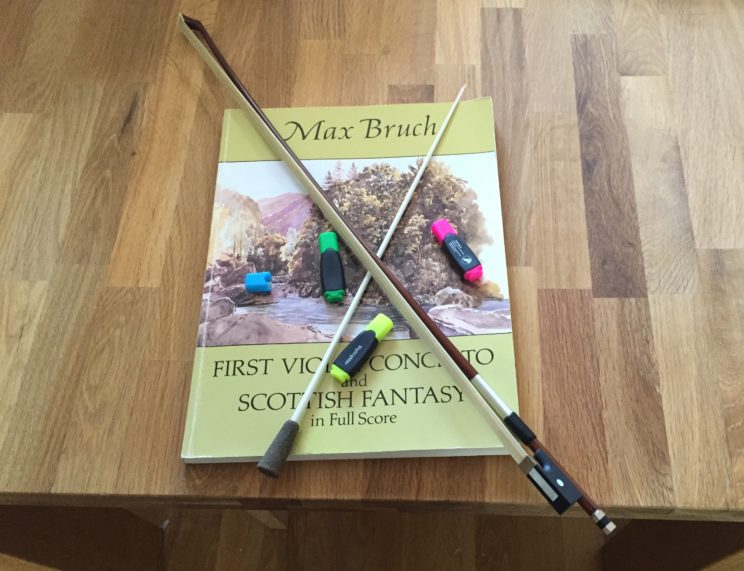The nearly-washed-up conductor Robert von Bohyarti, former Decca recording artist and long-time conductor of the Minneapolis Philharmonia, is considering launching a solo violin career, it has been learned. Bohyarti, whose instrument is the piano, is reported to feel “a little bored at this stage conducing the same handful of Beethoven and Brahms symphonies over and over again,” saying “I find myself craving new challenges and new repertoire.”
While colleagues in the orchestra wished von Bohyarti well should he choose to pursue a career as a violin soloist, a number of them expressed skepticism about the conductor’s motives for his career change. “I wouldn’t say von Bohyarti is completely nearly-washed-up,” said principal violist David Bratschemeister, “he can still dispatch a pretty good Tchaik 5 on a special occasion when he puts the work in. But his four pattern isn’t what it once was- his second beat is creeping up so it’s not on the same plane as his downbeat, and his cuing is not as precise as it once was. Last year, he gave a cue in The Planets and I couldn’t tell whether he was cueing the second or third clarinet.”
Opinions vary on how age affects the skills of conductors and what causes them to become nearly-washed-up. Professor Boyle D. Hamm at Southwestern Kansas State Community College said “elite conductors, like elite athletes, invariably lose muscle twitch as they get older. A conductor in his late 50’s like Maestro von Bohyarti will not have the same explosion in his upbeat that he will have had in his 20’s, and he’ll not be able to conduct as fast or as loud as he could earlier in his career.”
However, internationally recognized conducting coach and performance guru Rheinhold Zudick believes that age is not always the prime reason for a mid-career decline in skills, and that becoming nearly-washed-up is more likely the result “of a combination of factors to do with time management, repertoire fatigue and waning motivation. Maintaining a world class conducting technique takes constant practice—it’s like training for an Olympic event for your entire life. I would think that von Bohyarti, like many middle-aged athletes and musicians, struggles to find the will to continue to spend the necessary eight hours a day practicing his beat patterns in front of a mirror. But you remember what Fritz Reiner said- “less than eight hours a day in front of the mirror and I know something is wrong, less than seven hours a day in front of the mirror and the critics know something is wrong, and less that six hours a day in front of the mirror, and the public know something is wrong.” If you want to stay at the top, you’ve got to keep climbing.”
Concerns were raised as to whether von Bohyarti might be nearly-washed-up following a performance of La Mer with the Orchestre Symphonique de Paris Sud which critics slammed as being “very nearly flawless and enchanting, beautifully balanced and shaped, but just lacking that last tiny bit of effervescent sparkle.”
“Eet ees true, Chef Bohyarti did struugelle a beet in zi Debussy,” said OSPS general manager Pierre de l’Égout. “Being unable to deliver zee last tiny beet of effervescent sparkle is often a sign that a conducteur is becoming almost neerly-washed-oop.”
New York-based mega-agent Donald Wontford, who has represented Bohyarti since the glory days of his integral Havergal Brian cycle for Deutsche Grammophon in the 1970’s, firmly denied implications that his client’s conducting skills were eroding. “I reject absolutely the suggestion that Robert is approaching becoming almost nearly-washed-up as a conductor. Yes, it’s true he had some struggles with his four pattern recently, but all conductors do at some point. His three pattern remains one of the best in the industry, and I saw him do some cutoffs earlier this year that were as good as I’ve come across in 90 years running this company from my bomb-proof underground bunker.”
“This is not about being nearly-washed-up”, said Wontford, “it’s about a need for new challenges and personal growth, and it started with Robert’s aspiration to grow as an artist, not as a result of widespread critical concerns about his handling of tempo changes in Beethoven symphonies, or worries that his hair flips are not what they once were.”
Bohyarti said his dream of becoming a solo violinist was born almost by accident. “I came home late one night from a concert. I was tired and maybe had a few glasses of champagne at the reception, so I turned on the television to wind down. You never know what you’ll see on in the wee hours of the night. Anyway, there was this fascinating documentary about how the actor John Malkovich, who I really loved in that movie about the jewel thief, decided in mid career to become a puppeteer without any prior training. I thought that was just so inspiring, and so I called Donald the next morning and said I wanted to be a solo violinist, and next month I’m playing my first Bruch Concerto with the Dallas Philharmonic.”
Bohyarti dismissed concerns that his lack of violin training might limit his success as a violin soloist. “There are so many similarities- that’s why so many nearly-washed-up solo violinists become conductors. Any good violinist will tell you that all the sound comes from the right arm, which moves in a very similar way to a baton. It’s just that on the violin, it’s so much simpler- they only have to move the right arm back and forth from side to side. Just two directions, where a conductor has to master four: down, in, out and up! I’m finding it so liberating to simplify and focus on just two dimensions after so many years of being a four dimensional musician.”
“I’ve conducted an orchestra with one of the great violin sections in the world for over 20 years, and I’ve worked with every great violin soloist of the last two generations. I’ve watched them all very carefully to see which hand the bow goes in, what side of the face the violin goes on, everything. I think I know more about violin playing than a lot of these young kids out of Curtis and Juilliard! They may have the chops, but they haven’t lived with the repertoire- I’ve conducted the Brahms Violin Concerto dozens of times, and to do that, I had to learn about twenty different orchestral parts. The solo violinist only has to play one part!”
In spite of his confidence, von Bohyarti says he’s been treating his new career with all due seriousness of purpose. “I’ve always been an autodidact. I couldn’t see the point of going for a lesson with some loser violin professor at Eastman who makes less in a year than I make in a night. I’ve taught conducting all over the world, so I’m teaching myself violin the same way I would teach a young conductor to conduct. I’ve carefully marked up the solo part of the Bruch as I would prepare a Brahms symphony. Green highlighter for first finger notes, yellow for second, blue for third and red for fourth finger- to signal danger!”
“I’ve also been watching tons of YouTube videos. That’s the foundation on which great musicianship is built. You’ve got to study how the great violinists get the music across. I must have spent five hundred hours just watching Horst Herdenglocke videos. Of course, he sounds good, but he’s such a great communicator. I’ve conducted Horst many times, and to me, he’s the Carlos Kleiber of violinists. But I love all the modern players- they’re all so visually exciting to watch.
“It’s interesting to study how violin technique has improved so much since the invention of film and video. The older generation like Oistrakh, Milstein and Heifitz just sort of stood still and played. It’s so primitive. Today, almost every violinist I work with has the most incredible moves. I look at the way they swim their upper bodies, walk around, shake their heads and toss their hair and I just think “that is the essence of great musicianship.””
With just over a month until his solo debut, von Bohyarti could hardly contain his enthusiasm: “I feel bad for young violinists, having to go out on the circuit with all these horrible regional orchestras. I’m not sure my ears could cope with working with orchestras like that– I’m used to working with the best. I’m so glad that my success as a conductor means I can start at the top with a really great orchestra like the Dallas Philharmonic. My Strad arrives on Tuesday, and that gives me well over two and a half weeks to translate everything I’ve worked on studying YouTube videos into a really great performance of the Bruch Violin Concerto. I really can’t wait.”



Recent Comments